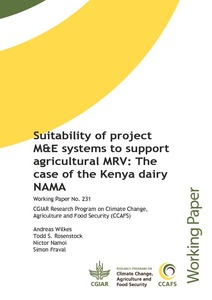Suitability of project M&E systems to support agricultural MRV: the case of the Kenya dairy NAMA
 Several countries are developing nationally appropriate mitigation actions (NAMAs) in the livestock sector. Compared to research on emission factors, much less attention has been paid to understanding systems for collecting activity data on change in livestock management practices and animal performance. This paper presents a framework for synthetic assessment of MRV systems based on UNFCCC criteria for credible MRV. The framework is applied to case studies of two existing monitoring and evaluation systems in Kenya’s dairy sector to investigate the extent to which these systems could be used as the basis for collection and reporting of activity data for a dairy sector NAMA in Kenya. Analysis of the case studies highlights three main findings: (i) codifying data collection, management procedures and roles is important for increasing transparency, while quality control and quality assurance systems play key roles in increasing confidence in data quality; (ii) milk yield is a key indicator used in estimating GHG emissions in the dairy sector, but further research is needed on potential sources of uncertainty and bias associated with different data collection methods; (iii) the involvement of multiple institutions in implementation of the sector- wide NAMA raises challenges related to the consistency and comparability between data collected by different institutions. Options for improvement in MRV practices will be determined to a large extent by the requirements of data users. These issues are not unique to Kenya’s dairy NAMA. Further assessment of the quality of activity data and the characteristics of credible MRV systems will support practical improvements in MRV for agricultural mitigation actions.
Several countries are developing nationally appropriate mitigation actions (NAMAs) in the livestock sector. Compared to research on emission factors, much less attention has been paid to understanding systems for collecting activity data on change in livestock management practices and animal performance. This paper presents a framework for synthetic assessment of MRV systems based on UNFCCC criteria for credible MRV. The framework is applied to case studies of two existing monitoring and evaluation systems in Kenya’s dairy sector to investigate the extent to which these systems could be used as the basis for collection and reporting of activity data for a dairy sector NAMA in Kenya. Analysis of the case studies highlights three main findings: (i) codifying data collection, management procedures and roles is important for increasing transparency, while quality control and quality assurance systems play key roles in increasing confidence in data quality; (ii) milk yield is a key indicator used in estimating GHG emissions in the dairy sector, but further research is needed on potential sources of uncertainty and bias associated with different data collection methods; (iii) the involvement of multiple institutions in implementation of the sector- wide NAMA raises challenges related to the consistency and comparability between data collected by different institutions. Options for improvement in MRV practices will be determined to a large extent by the requirements of data users. These issues are not unique to Kenya’s dairy NAMA. Further assessment of the quality of activity data and the characteristics of credible MRV systems will support practical improvements in MRV for agricultural mitigation actions.
